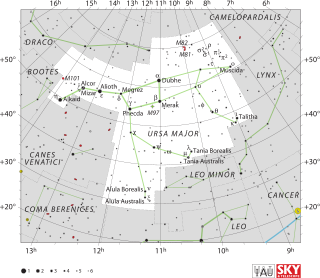Phecda
| Observation data Epoch J2000 Equinox J2000 |
|
|---|---|
| Constellation | Ursa Major |
| Right ascension | 11h 53m 49.84732s |
| Declination | +53° 41′ 41.1350″ |
| Apparent magnitude (V) | +2.438 |
| Characteristics | |
| Spectral type | A0 Ve |
| U−B color index | +0.008 |
| B−V color index | –0.013 |
| Astrometry | |
| Radial velocity (Rv) | −12.6 km/s |
| Proper motion (μ) |
RA: +107.68 mas/yr Dec.: +11.01 mas/yr |
| Parallax (π) | 39.21 ± 0.40mas |
| Distance | 83.2 ± 0.8 ly (25.5 ± 0.3 pc) |
| Details | |
| Mass | 2.62 M☉ |
| Radius | 3.04 ± 0.08 R☉ |
| Surface gravity (log g) | 3.79 cgs |
| Temperature | 9,355 K |
| Rotational velocity (v sin i) | 178 km/s |
| Age | 0.3 Gyr |
| Other designations | |
| Database references | |
| SIMBAD | data |
Gamma Ursae Majoris (γ Ursae Majoris, abbreviated Gamma UMa, γ UMa), also named Phecda, is a star in the constellation of Ursa Major. Since 1943, the spectrum of this star has served as one of the stable anchor points by which other stars are classified. Based upon parallax measurements with the Hipparcos astrometry satellite, it is located at distance of around 83.2 light-years (25.5 parsecs) from the Sun.
It is more familiar to most observers in the northern hemisphere as the lower-left star forming the bowl of the Big Dipper, together with Alpha Ursae Majoris (Dubhe, upper-right), Beta Ursae Majoris (Merak, lower-right) and Delta Ursae Majoris (Megrez, upper-left). Along with four other stars in this well-known asterism, Phecda forms a loose association of stars known as the Ursa Major moving group. Like the other stars in the group, it is a main sequence star not unlike the Sun, although somewhat hotter, brighter and larger.
Gamma Ursae Majoris is an Ae star, which is surrounded by an envelope of gas that is adding emission lines to the spectrum of the star; hence the 'e' suffix in the stellar classification of A0 Ve. It has 2.6 times the mass of the Sun, three times the Sun's radius, and an effective temperature of 9,355 K in its outer atmosphere. This star is rotating rapidly, with a projected rotational velocity of 178 km s−1. The estimated angular diameter of this star is about 0.92 mas. It has an estimated age of 300 million years.
...
Wikipedia

